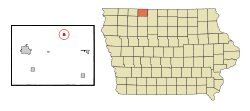Dolliver, Iowa
Dolliver is a city in Emmet County, Iowa, United States. The population was 66 at the 2010 census.
Dolliver, Iowa | |
|---|---|
 Location of Dolliver, Iowa | |
| Coordinates: 43°27′53″N 94°36′54″W | |
| Country | |
| State | |
| County | Emmet |
| Area | |
| • Total | 0.36 sq mi (0.94 km2) |
| • Land | 0.36 sq mi (0.94 km2) |
| • Water | 0.00 sq mi (0.00 km2) |
| Elevation | 1,280 ft (390 m) |
| Population | |
| • Total | 66 |
| • Estimate (2019)[3] | 59 |
| • Density | 162.09/sq mi (62.58/km2) |
| Time zone | UTC-6 (Central (CST)) |
| • Summer (DST) | UTC-5 (CDT) |
| ZIP code | 50531 |
| Area code(s) | 712 |
| FIPS code | 19-21675 |
| GNIS feature ID | 0455948 |
History
Dolliver got its start in the year 1899, following the construction of the Chicago and North Western Railway through that territory.[4] It is named for United States Senator Jonathan P. Dolliver.[5] The railroad line on which the town was established was shut down in the early 1970s.
Geography
Dolliver is located at 43°27′53″N 94°36′54″W (43.464821, -94.614877).[6]
According to the United States Census Bureau, the city has a total area of 0.36 square miles (0.93 km2), all land.[7]
Demographics
| Year | Pop. | ±% |
|---|---|---|
| 1910 | 107 | — |
| 1920 | 171 | +59.8% |
| 1930 | 158 | −7.6% |
| 1940 | 179 | +13.3% |
| 1950 | 130 | −27.4% |
| 1960 | 122 | −6.2% |
| 1970 | 95 | −22.1% |
| 1980 | 125 | +31.6% |
| 1990 | 103 | −17.6% |
| 2000 | 77 | −25.2% |
| 2010 | 66 | −14.3% |
| 2019 | 59 | −10.6% |
| Source:"U.S. Census website". United States Census Bureau. Retrieved 2020-03-29. and Iowa Data Center Source: | ||
2010 census
As of the census[2] of 2010, there were 66 people, 34 households, and 18 families living in the city. The population density was 183.3 inhabitants per square mile (70.8/km2). There were 42 housing units at an average density of 116.7 per square mile (45.1/km2). The racial makeup of the city was 100.0% White.
There were 34 households, of which 17.6% had children under the age of 18 living with them, 41.2% were married couples living together, 2.9% had a female householder with no husband present, 8.8% had a male householder with no wife present, and 47.1% were non-families. 35.3% of all households were made up of individuals, and 11.8% had someone living alone who was 65 years of age or older. The average household size was 1.94 and the average family size was 2.44.
The median age in the city was 52 years. 12.1% of residents were under the age of 18; 3.1% were between the ages of 18 and 24; 21.3% were from 25 to 44; 35% were from 45 to 64; and 28.8% were 65 years of age or older. The gender makeup of the city was 53.0% male and 47.0% female.
2000 census
As of the census[9] of 2000, there were 77 people, 38 households, and 19 families living in the city. The population density was 210.9 people per square mile (80.4/km2). There were 46 housing units at an average density of 126.0 per square mile (48.0/km2). The racial makeup of the city was 98.70% White and 1.30% Asian. Hispanic or Latino of any race were 3.90% of the population.
There were 38 households, out of which 10.5% had children under the age of 18 living with them, 50.0% were married couples living together, and 47.4% were non-families. 39.5% of all households were made up of individuals, and 28.9% had someone living alone who was 65 years of age or older. The average household size was 2.03 and the average family size was 2.70.
In the city, the population was spread out, with 13.0% under the age of 18, 7.8% from 18 to 24, 24.7% from 25 to 44, 29.9% from 45 to 64, and 24.7% who were 65 years of age or older. The median age was 48 years. For every 100 females, there were 102.6 males. For every 100 females age 18 and over, there were 91.4 males.
The median income for a household in the city was $28,036, and the median income for a family was $34,375. Males had a median income of $28,750 versus $21,944 for females. The per capita income for the city was $18,387. None of the population and none of the families were below the poverty line.
Education
Estherville-Lincoln Central Community School District operates area public schools.[10] It was established on July 1, 1997 by the merger of the Estherville and Lincoln Central school districts.[11]
References
- "2019 U.S. Gazetteer Files". United States Census Bureau. Retrieved July 17, 2020.
- "U.S. Census website". United States Census Bureau. Retrieved 2012-05-11.
- "Population and Housing Unit Estimates". United States Census Bureau. May 24, 2020. Retrieved May 27, 2020.
- History of Emmet County and Dickinson County, Iowa. Pioneer Publishing Company. 1917. pp. 126.
- Chicago and North Western Railway Company (1908). A History of the Origin of the Place Names Connected with the Chicago & North Western and Chicago, St. Paul, Minneapolis & Omaha Railways. p. 65.
- "US Gazetteer files: 2010, 2000, and 1990". United States Census Bureau. 2011-02-12. Retrieved 2011-04-23.
- "US Gazetteer files 2010". United States Census Bureau. Archived from the original on 2012-07-02. Retrieved 2012-05-11.
- "Census of Population and Housing". Census.gov. Retrieved June 4, 2015.
- "U.S. Census website". United States Census Bureau. Retrieved 2008-01-31.
- "Estherville-Lincoln Central" (PDF). Iowa Department of Education. Retrieved 2020-03-27.
- "REORGANIZATION & DISSOLUTION ACTIONS SINCE 1965-66" (PDF). Iowa Department of Education. Archived from the original (PDF) on 2019-02-09. Retrieved 2019-08-01.